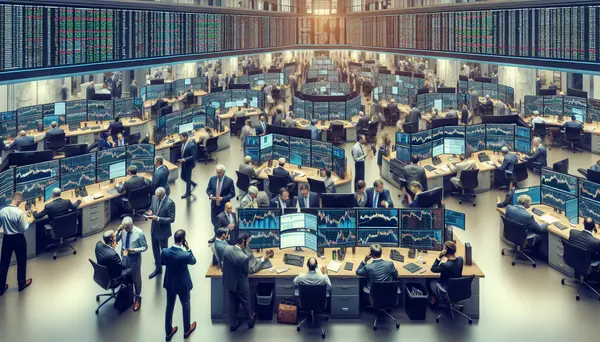Table of Contents:
Introduction: Unveiling the Role of Behavioral Economics in Trading Decisions
As we venture into the world of cryptocurrencies, understanding how our behaviors influence our trading decisions can provide invaluable insights. This introduction to the role of behavioral economics in trading will delve into the various factors that steer our financial choices, particularly in the dynamic domain of cryptocurrencies.
Behavioral economics, at its core, investigates how people's emotions, biases, and cognitive processes affect their economic decisions. It challenges the classical economic theory that individuals are purely rational actors. Delving into this realm allows us to understand the psychological forces at play when we make trading decisions.
Regardless of whether you are a seasoned trader or a novice in the crypto world, understanding behavioral economics can help manage risk, avoid common trading fallacies, and ultimately, make more informed decisions. So, let’s get started with our journey into the fascinating world of behavioral economics.
Understanding the Basics: What is Behavioral Economics?
When we talk about Behavioral Economics— it's a subfield of economics exploring why people sometimes make irrational decisions, and why their behavior does not align with traditional economics' predictions. In other words, it's the study of how psychological influences, social factors, and emotional states can impact the economic decisions of individuals and institutions, and the consequences that may ripple across the broader market.
Underlying this field of study are the concepts of cognitive biases, heuristics, and emotions. Cognitive biases refer to systematic errors in thinking that can affect one's choices and decisions. Heuristics, on the other hand, are mental shortcuts that help individuals make swift decisions. Emotions, undeniably, can also significantly sway our decision-making skills, especially in high-stakes environments like trading.
The interesting element of behavioral economics is that it applies to everyone - from the stock market's movers and shakers to average individuals exploring the world of cryptocurrencies.
Diving Deeper: Principles of Behavioral Economics
Now that we have an overview of behavioral economics, let's delve deeper into a few core principles that govern this field - loss aversion, decision-making under uncertainty, and herd behavior.
Loss Aversion refers to the tendency of individuals to prefer avoiding losses over acquiring equivalent gains. Simply put, the pain of losing is psychologically about twice as powerful as the pleasure of gaining. In trading, this can lead to irrational decisions like holding on to a losing asset for too long in the hope of a price rebound.
Under the umbrella of behavioral economics, also lies the concept of Decision-making under Uncertainty. Often, traders have to make decisions with imperfect information, leading to reliance on heuristics or gut feelings. However, this can introduce biases and potentially lead to poor trading outcomes.
Herd Behavior is another principle closely associated with behavioral economics. It's the phenomenon where individuals follow the behavior of a larger group, even if it defies their individual reasoning or the objective information available. In the context of trading, herd behavior can cause market bubbles or crashes as a large number of traders act in unison.
It's essential to remember that these principles of behavioral economics aren't an exhaustive list. But, they serve as a solid foundation to understand how emotions, biases, and cognitive processes can significantly influence trading decisions.
Connecting the Dots: The Intersection of Trading and Behavioral Economics

Digging deeper, we can begin to illustrate how behavioral economics intersects with trading in practical terms. When we speak of trading, it's not just the action of buying or selling that matters. The pivotal aspect lies in the ability to make calculated, objective decisions amidst market volatility and uncertainty. This is where behavioral economics comes into play.
For example, consider the instance of a sudden drop in the price of a cryptocurrency. A classical economics approach would suggest that a trader react based on the factual statistics, trends, and patterns. However, that's not always the case. Behavioral economic principles illustrate that emotions or cognitive biases, like fear of loss or herd behavior, could overpower logical decision-making, leading traders to make impulsive selling decisions.
Moreover, the cognitive bias known as overconfidence can directly impact a trader's decision-making process. Overconfidence refers to our inherent tendency to overestimate our abilities and the precision of our information. In the realm of trading, this could lead to risky bets and overtrading, potentially resulting in substantial losses.
A solid grasp of behavioral economics equips traders with recognition of these internal and external factors that might be influencing their trading decisions unconsciously. It emphasizes the need for self-awareness, critical analysis, and continuous learning as key tools for effective trading.
This overlap between trading and behavioral economics thus provides substantial insights into how we make trading decisions and how we can make them better.
Real-World Applications: Case Studies of Behavioral Economics in Trading
An excellent way to visualize the application of behavioral economics in trading is by looking at real-world instances. Let's explore two notable case studies that illuminate the profound impact of our behavioral tendencies on our trading decisions.
The Dot-Com Bubble of the late 1990s and early 2000s serves as a perfect example of herd mentality, a principle of behavioral economics. Traders and investors, driven by the euphoria surrounding the new digital era, excessively speculated on tech stocks, causing a market bubble. The general atmosphere led many traders to overlook fundamental analysis and join the bandwagon. Ultimately, when reality did not meet expectations, the market crash led to severe losses.
Another case study demonstrating the influence of loss aversion is the 2008 financial crisis. Many traders held on to their mortgage-backed securities, despite witnessing the decline in housing prices and increasing default rates. Their behavior could be attributed to loss aversion, expecting the market to make a favorable turn.
These cases highlight how, by combining an understanding of behavioral economics with traditional economic models, traders can potentially make better-informed decisions and avoid similar financial pitfalls.
Conclusion: Navigating the Trading Terrain with Behavioral Economics

In conclusion, it's clear that behavioral economics plays a significant role in influencing trading decisions. Understanding its principles can provide traders with essential insights about their own biases and tendencies, helping them steer clear of potential pitfalls. As we dive deeper into the vast sea of cryptocurrencies, applying these principles of behavioral economics could potentially help to navigate the tumultuous waters with greater confidence and effectiveness.
Remember, at the end of the day, the trading arena is not only a test of technical skills and market cognizance, but it's also a psychological game. As we embrace behavioral economics, we equip ourselves with more than just information - we arm ourselves with holistic knowledge to make sound trading decisions. After all, the power to make better financial decisions is, quite literally, in our minds.
Implications: How Behavioral Economics Influences Trading Decisions
Having a grasp of the fundamental principles of behavioral economics, it's time to explore its implications in influencing trading decisions. It's worth noting that these psychological factors shape not only our individual decisions, but also the collective market sentiment, leading to significant market fluctuations.
Firstly, behavioral economics helps us comprehend the triggers behind panic selling. It is a scenario where traders, driven largely by fear or anxiety, sell off their assets rapidly and often irrationally, causing a sharp fall in asset prices. Similarly, the principles of behavioral economics can also explain the phenomenon of FOMO (Fear of Missing Out). This is where traders, anxious not to miss out on potential profits, may hastily buy into a trend, pushing prices upward.
Secondly, behavioral economics reveals a lot about a trader's risk tolerance levels. Traders influenced heavily by loss aversion may tend towards conservative strategies aiming to minimize losses. On the other hand, those ruled by overconfidence might take on riskier ventures, counting on their perceived abilities rather than the actual market conditions.
Furthermore, decision-making in uncertain market situations is often intertwined with behavioral economics principles. Traders, bound by the inadequacy of information, resort to simple rule-of-thumb strategies or follow the crowd, sometimes resulting in suboptimal trading decisions.
In essence, the way traders react to gains, handle losses, perceive risk, and respond to market trends is shaped largely by the principles of behavioral economics. Recognizing these hidden psychological influences can be pivotal in enhancing trading effectiveness and profitability.
Mastering the game: Strategies to Counter Behavioral Biases in Trading

Having explored the role of behavioral economics in trading decisions, it's essential to discuss strategies that can help to counter these behaviors and improve trading outcomes. Below, we discuss three practical strategies: developing a structured trading plan, practicing emotional discipline, and indulging in continuous learning.
Develop a structured trading plan: A structured trading plan can serve as a roadmap for trading decision-making, invariably helping to combat impulsiveness and overconfidence. It defines clear guidelines on aspects such as the amount to be invested, exit strategies, and risk tolerance levels. A well-planned strategy that is adhered to consistently can help traders to stay grounded and make rational decisions amidst market volatility.
Practice emotional discipline: Emotions can be a trader's most significant adversary. Overcoming this requires practice and awareness. Traders should endeavor to maintain emotional discipline, resisting the urge to make snap decisions driven by fear or greed. An emotionally disciplined trader can uphold strategy and reason in the face of market turbulence.
Continuous learning: The world of trading is dynamic and ever-evolving. Continuous learning, backed by regular market analysis, can help traders remain ahead of the game. As knowledge grows, the understanding of behavioral biases and their impact also deepens, better equipping individuals to identify and counteract these influences in their trading decisions.
In conclusion, the intersection of behavioral economics and trading offers an insightful perspective to traders at all levels. By understanding and adapting to the emotional and psychological influences on trading decisions, one can elevate their trading strategies and optimize their financial outcomes.
Final Takeaway: Harnessing Behavioral Economics for Smarter Trading Decisions
As we glean insights into the intertwining realms of behavioral economics and trading, it's clear that understanding our cognitive processes can directly impact our trading strategies and financial outcomes.
By recognizing our inherent biases and emotional tendencies, we can craft trading strategies that compensate for these human idiosyncrasies. Whether it's overcoming herd behavior, handling loss aversion, or making decisions under uncertainty, the key lies in self-awareness and continuous learning.
It's important to steer clear of knee-jerk decisions and instead focus on a data-driven, objective approach to trading. This certainly doesn't mean that emotions and instincts have no part to play. However, they need to be tamed and integrated into a balanced, informed perspective.
Behavioral economics doesn't promise a sure-shot formula for trading success. Rather, it equips traders with a robust framework to understand their own and others' financial behaviors better. In the volatile world of cryptocurrency trading, this can be a potent tool.
In conclusion, as we navigate the tumultuous seas of trading decisions, let's remember that our minds are our best friends and our worst enemies. By harnessing the principles of behavioral economics, we can aspire to be smarter, more aware traders, capable of making calculated, rational decisions in the face of market uncertainties.
Frequently Asked Questions
What is the role of behavioral economics in trading decisions?
Behavioral economics plays a crucial role in trading decisions. It helps to explain the psychological factors that drive the decisions of traders, which traditional economics might not be able to explain. This includes biases, heuristics, emotions, and social factors that influence trading decisions.
How does behavioral economics impact the trading market?
Behavioral economics has significant implications for the trading market. An understanding of the behavioral biases that can influence traders' decisions can help in predicting market trends and making more strategic trading decisions.
What are some common behavioral biases in trading?
Some common behavioral biases in trading include overconfidence, herd instinct, anchoring bias, loss aversion, and confirmation bias.
Can behavioral economics lead to more successful trading?
Yes, understanding behavioral economics can lead to more successful trading. By being aware of the biases and heuristics that can impact trading decisions, traders can make more rational and strategic decisions.
What is the future of behavioral economics in trading?
The future of behavioral economics in trading is promising. As the finance industry continues to recognize the importance of understanding human behavior in trading decisions, the role of behavioral economics is likely to grow more significant.












